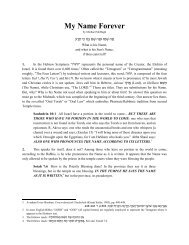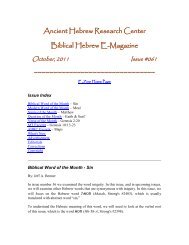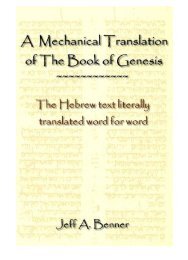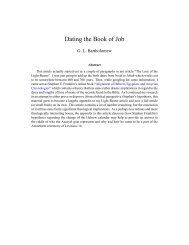Ancient Hebrew Language and Alphabet
Ancient Hebrew Language and Alphabet
Ancient Hebrew Language and Alphabet
Create successful ePaper yourself
Turn your PDF publications into a flip-book with our unique Google optimized e-Paper software.
Appendix A – <strong>Alphabet</strong> Reconstruction<br />
ago. This is the only pictograph for which the original<br />
two-letter name cannot be found. We then turn to the<br />
culture of the <strong>Ancient</strong> <strong>Hebrew</strong>s <strong>and</strong> sister cultures to find<br />
the original name. Many Near Eastern cultures<br />
worshipped the god "la / el or al", depicted as a bull in<br />
their carvings of the god. When Israel formed an image of<br />
God at Mount Sinai they chose a calf (young bull). This<br />
evidence shows that the word "la / el" was understood to<br />
be a bull.<br />
Phonetic (sound): In Modern <strong>Hebrew</strong> as well as Arabic,<br />
this letter is silent but did have an "a" sound when the<br />
Greek language adopted it. This letter was originally a<br />
vowel <strong>and</strong> most likely an "ah" sound.<br />
Beyt<br />
Pictographic (form): The <strong>Hebrew</strong> word beyt means<br />
"house" or "tent". There are various suggestions to the<br />
original form of this letter including , , <strong>and</strong> .<br />
The picture is a perfect representation of the nomadic<br />
tent which was divided into two sections, a men's <strong>and</strong><br />
women's, with the entrance at the front of the tent in the<br />
men's section <strong>and</strong> an entrance from the men's to the<br />
women's section.<br />
Mnemonic (meaning): Family -- the residents of the tent;<br />
Inside -- the family that is inside the tent is of importance,<br />
not the structure itself.<br />
54






